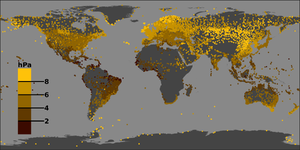We had an informative discussion going in one of @Ucsdryders threads and I wanted to move it to its own space.
@Formidilosus and @Marbles shared some good information and I’m wondering if you guys could generalize how you handle long range ballistics factoring in environmental conditions at different altitudes.
I’ve found that by the time somebody pulls out a kestrel or a phone and inputs all of their weather information etc, they have either lost sight of the animal, the yardage has changed on a moving target and they have to change their number, or they fumble around and never get a shot off.
I’m looking for real world tactics used to get proper environmental conditions when hunting and time is short. Meaning, you don’t have time or internet for a full real world current density altitude calculation.
I use an old, very basic line graph chart that I have laminated on a key ring. This line graph gives you a simple to follow “cheat sheet” for obtaining basic density altitude. On the same key ring are color coded laminated cards, sorted in order by temp. So red cards are 3,000 foot DA, orange cards are 5,000 foot DA, yellow cards are 7,000 foot DA etc. They are then in order from temp low to high with bold numbers to see elevation and wind corrections. This is small enough to fit in my pocket or bino harness and access instantly.
I make these cards up before going on a hunt with planned hunting elevations and known weather forecast. That way the key ring isn’t crazy with too many cards.
Is there a more effective way to manage this? I’ve been lucky to have good success with multiple long range kills per year using this method but I’d love to learn more.
@Formidilosus and @Marbles shared some good information and I’m wondering if you guys could generalize how you handle long range ballistics factoring in environmental conditions at different altitudes.
I’ve found that by the time somebody pulls out a kestrel or a phone and inputs all of their weather information etc, they have either lost sight of the animal, the yardage has changed on a moving target and they have to change their number, or they fumble around and never get a shot off.
I’m looking for real world tactics used to get proper environmental conditions when hunting and time is short. Meaning, you don’t have time or internet for a full real world current density altitude calculation.
I use an old, very basic line graph chart that I have laminated on a key ring. This line graph gives you a simple to follow “cheat sheet” for obtaining basic density altitude. On the same key ring are color coded laminated cards, sorted in order by temp. So red cards are 3,000 foot DA, orange cards are 5,000 foot DA, yellow cards are 7,000 foot DA etc. They are then in order from temp low to high with bold numbers to see elevation and wind corrections. This is small enough to fit in my pocket or bino harness and access instantly.
I make these cards up before going on a hunt with planned hunting elevations and known weather forecast. That way the key ring isn’t crazy with too many cards.
Is there a more effective way to manage this? I’ve been lucky to have good success with multiple long range kills per year using this method but I’d love to learn more.


